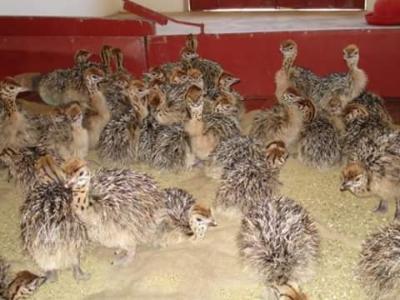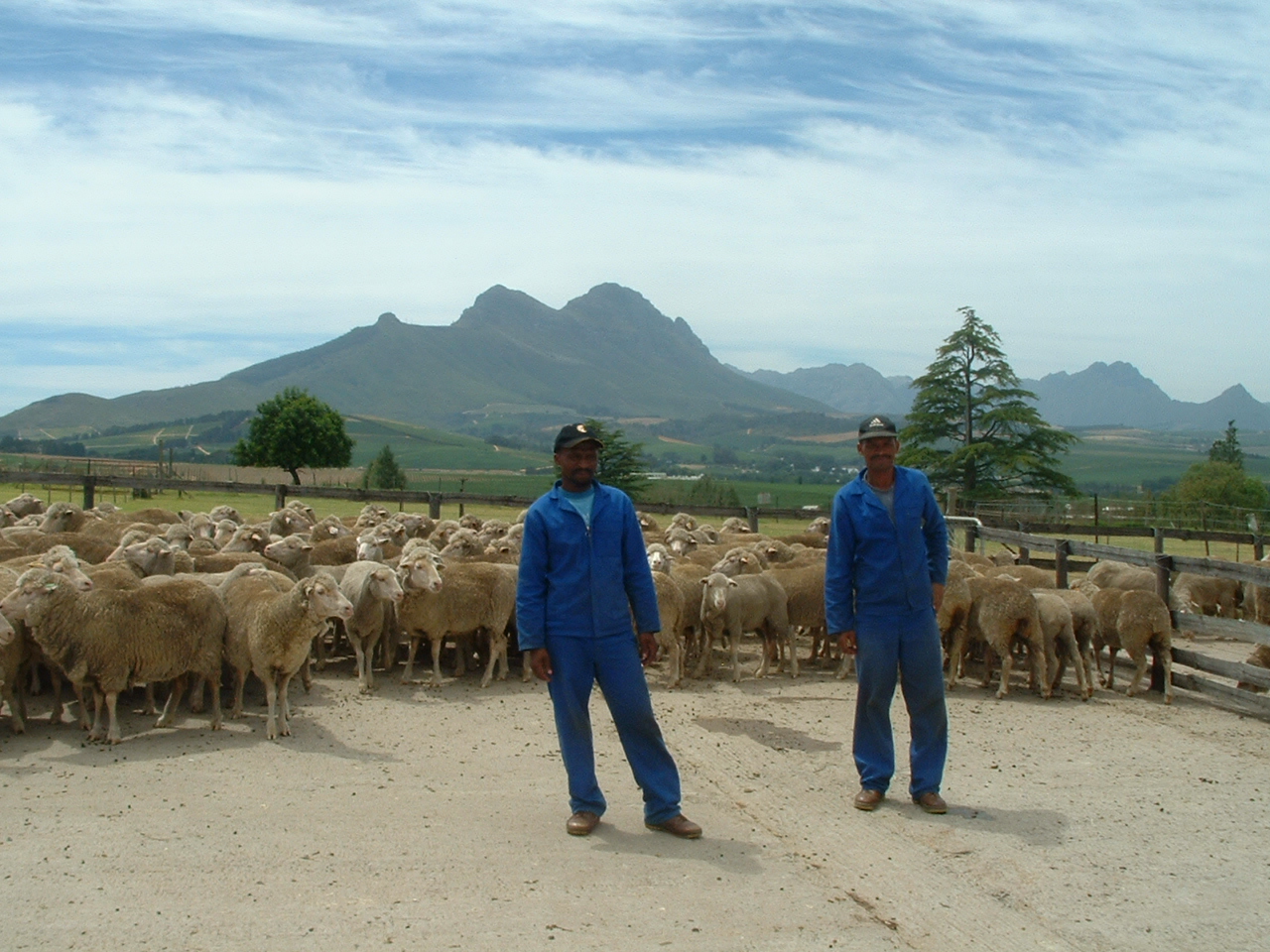Discovering biomarkers for breeding strategies to improve livestock production and fitness
Published: 14 October 2015
Our collaborative research projects has brought together endocrine expertise from the University of Glasgow with animal scientists within the Western Cape Department of Agriculture (South African Government) to identify potential biomarkers for use in breeding strategies to improve animal production and welfare (sheep and ostrich industries), as well as understanding the genetic mechanisms that are involved in the interplay between the stress and reproductive endocrine axes.
Sheep
The South African small stock industry relies mostly on meat and wool as sources of revenue for producers. There is currently a drive within the Western Cape Department of Agriculture to increase production output by 10% over the next 10 years. One recommendation to farmers is to select ewes based on their ability to rear multiple offspring per mating opportunity. This follows from an industry funded program of divergent selection for (High-line) or against (Low-line) multiple rearing capacity in sheep, which has demonstrated the positive effects of selection on reproductive output (total weight of lamb weaned per lambing opportunity; number of lambs born and weaned per ewe; gestation length). Interestingly the selection lines also differed in a series of correlated responses: maternal care and behaviour during the peripartum period; lamb progression after birth; behavioural responses to isolation stress; and cortisol responses to physiological stress. This selection criterion therefore increased both the “efficiency” of production for sheep farmers and the overall fitness of the sheep. Importantly, the selection criterion used in this program also did not generally have a negative trade-off effect on production traits, such as wool and meat production. Indeed, the ewes showing increased reproductive efficiency were typically heavier and plainer (based on live weight and wrinkle score) and had wool with higher staple strength, but indifferent fibre diameter. However, they did produce lower amounts of clean wool between the ages of 2-6 years (no difference at 2 or 7 years of age). This was previously ascribed to the higher metabolic demand on High-line sheep due to the higher reproduction rate, because there was no evidence of genetic divergence for fleece weight in genetic trends for progeny of the two lines.
To ensure the sustainability of the selection criteria for multiple rearing capacity as breeding goal, it is essential that additional studies are conducted to characterize the physiological basis for the increase in reproductive potential and ensure that there is not a negative trade-off between reproduction and production. Furthermore, these studies might reveal biomarkers that could accelerate genetic progress in breeding strategies. A previous study by Hough et al. (2013) indicated between-line differences in the endocrine elements of the hypothalamic-pituitary-adrenal (HPA) axis, which affects the ability of sheep to cope with short-term stress [Hough, 2012; Hough et al., 2013]. However, evidence is still lacking for the effects of this selection program on the endocrine reproductive axis, even though phenotypic reproductive traits have been well characterized.
In a collaborative research project between Glasgow University (Dr Denise Hough, Prof Neil Evans and Dr Jane Robinson) and the Western Cape Department of Agriculture (Prof Schalk Cloete), the aim is to determine whether the divergent selection for reproductive performance is caused by differences in the secretion or sensitivity of the hypothalamic-pituitary-gonadal (HPG) axis to the reproductive hormones gonadotrophin releasing hormone (GnRH), luteinising hormone (LH), follicle stimulating hormone (FSH), estradiol and progesterone. These hormones act in concert to regulate reproductive function. GnRH is secreted episodically from the hypothalamus into the pituitary portal blood vessels and regulates the amount and pattern of LH and FSH secretion which in turn regulate the production and secretion of the gonadal steroids, estradiol and progesterone, which feedback at the level of both the hypothalamus and pituitary gland to regulate the activity within the axis. Any between-line differences in the pattern of secretion of these hormones could ultimately affect reproduction potential, e.g. oestrous cycles, sexual behaviour, conception rate, and length of breeding season.
This study will contribute to our knowledge of how these traits are affected by endocrinological events, as well as offer aid to pinpointing the genes and mechanisms involved. The knowledge gained may be useful in developing strategies to aid in the identification and selection of ewes with superior reproductive function to ultimately improve production in the farming practices.
Ostriches

The domestication of ostriches is a relatively new development (established in South Africa in 1850), compared to the domestication of other farm animals, and therefore best farming practices are still largely being developed. South Africa is home to 70% of the worldwide ostrich population, with the largest concentrations of ostriches found in the town of Oudtshoorn. Ostriches are considered a versatile farm animal with commercial demand for their feathers, eggs, meat and leather. The meat is considered tasty and versatile due to its low cholesterol and fat content, and 95% of ostrich meat is exported, primarily to European countries. Compliance with the European Union food safety and animal health regulations are therefore required, for which there are 6 abattoirs and 600 ostrich farms registered and approved for export.
The South African ostrich industry is presently compromised by two main factors, namely poor egg hatchability and low chick survival. A research project by the Department of Agriculture in South Africa (Directorate: Animal Sciences) set out to investigate how general aspects of chick management and husbandry could be adapted to address this issue by investigating the effects of regular and gentle human contact at an early age (<3 months), called the ‘imprinting phase’. Preliminary results indicated that chick survival at 4 weeks of age was significantly higher among human-imprinted chicks (during 1-30 days of age) compared to chicks reared using standard production practices (without any difference in the quality of healthcare). Human-imprinted chicks were also more docile and easily managed during routine farm management practices at the juvenile stage (10-15 months of age).
A team of researchers at the University of Glasgow (Dr Denise Hough, Prof Neil Evans and Dr Jane Robinson) have collaborated with the South African research team (Dr Maud Bonato and Prof Schalk Cloete) in a project to characterise the physiological parameters associated with the different production systems and their relationship with chick survival. In this project, corticosterone will be extracted and quantified from ostrich feathers and related to physiological/behavioural data (i.e. survival, growth, behaviour during docility and fear test). Corticosterone is the principal adrenal stress hormone in birds and also plays an important homeostatic role in carbohydrate, protein and fat metabolism. The feathers have been obtained from three groups of birds: 1) standard husbandry practice; 2) human imprinting involving audio, visual and physical interaction; 3) human imprinting involving visual, audio and no physical interaction. The aim is to investigate the benefits of incorporating human-chick interactions within production systems for ostrich farming and whether feather corticosterone might be a good biomarker for stress/welfare when selecting ostriches for breeding purposes.
First published: 14 October 2015
People
Denise Hough
Neil Evans
Jane Robinson
Partners
Western Cape Department of Agriculture
To Learn More
Bonato, Maud, et al. "Extensive human presence at an early age of ostriches improves the docility of birds at a later stage of life." Applied Animal Behaviour Science 148.3 (2013): 232-239.
Cloete, J. J. E., S. W. P. Cloete, and L. C. Hoffman. "Behaviour of Merinos divergently selected for multiple rearing ability in response to external stimuli."Small Ruminant Research 60.3 (2005): 227-236.
Cloete, S. W. P., et al. "The development of ratite production through continued research." World's Poultry Science Journal 68.2 (2012): 323
Cloete, S. W. P., I. Misztal, and J. J. Olivier. "Genetic parameters and trends for lamb survival and birth weight in a Merino flock divergently selected for multiple rearing ability." Journal of animal science 87.7 (2009): 2196-2208.
Hough, D., et al. "Relative contribution of P450c17 towards the acute cortisol response: Lessons from sheep and goats." Molecular and cellular endocrinology 408 (2015): 107-113.
Hough, D., P. Swart, and S.W.P. Cloete. "Exploration of the hypothalamic-pituitary-adrenal axis to improve animal welfare by means of genetic selection: Lessons from the South African Merino." Animals 3.2 (2013): 442-474.
Wang, M. D., et al. "Foster parenting, human imprinting and conventional handling affects survival and early weight of ostrich chicks." South African Journal of Animal Science 42.2 (2012): 123-130.


